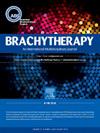PPP04 演讲时间:上午 10:57
IF 1.7
4区 医学
Q4 ONCOLOGY
引用次数: 0
摘要
目的高剂量率近距离放射治疗(HDR-BT)与体外放射治疗(EBRT)相结合,是一种被广泛接受的治疗临床局部前列腺癌患者的方法。已发表的系列研究报告显示,高剂量率近距离放射治疗(HDR-BT)对性健康相关的生活质量(sHRQoL)有明显影响。病因可能是多因素的,包括基线因素、创伤和神经血管束(NVB)的剂量。磁共振成像(MRI)可对神经血管束进行可视化和正确定位。在此,我们旨在分析 MRI 引导下全腺 HDR-BT 增效治疗前列腺癌后的长期 sHRQoL,并评估 NVB 剂量和其他因素对 sHRQoL 的影响。材料与方法61 例患者接受了单次 15 Gy MRI 引导下 HDR-BT 治疗,随后进行了 EBRT,这是一项经当地研究伦理委员会批准的前瞻性 II 期试验(09-0026-C)的一部分。本次分析排除了接受雄激素剥夺疗法(ADT)超过 12 个月的患者和/或有基线勃起功能障碍的患者。在T2加权图像上对左右两个NVB进行了回顾性划分。在基线、1个月、3个月、6个月、12个月以及此后每月的第12个季度(直至60个月),使用扩大的前列腺指数综合(EPIC)问卷对患者的性生活质量进行前瞻性收集。最小重要差异 (MID) 的定义是 3 个月时的 sHRQoL 评分恶化程度≥ 基线评分的 0.5 个标准差。采用线性回归模型和逻辑回归模型。15名患者接受了短期 ADT 治疗。基线性 HRQOL 平均得分为 48.1(SD=27.1):性功能为 41.9 (SD=28.5) 分,性困扰为 63.8 (SD=37.9) 分 (37.9)。在 12、24、36 和 60 个月时,平均性功能评分分别为 37.5 (SD=26.3)、47(SD=24.3)、45.1 (SD=20.4) 和 36.8 (SD=29.1),p>0.05。在 60 个月时,50% 的患者报告出现 MID。短程ADT患者60个月时的平均sHRQoL评分为44.1 (SD=27.1) 对32.2 (SD=31.1), p>0.05.NVB的平均划定体积右侧为0.35 cc ± 0.12,左侧为0.36 cc ± 0.13。使用针数的中位数为 18[四分位数间距(IQR):17-19]。左侧 NVB 的最大剂量中位数为 20.9 Gy (17.4-22.8),右侧 NVB 的最大剂量中位数为 21.1 Gy (19.0-24.0),阴茎球部的最大剂量中位数为 5.4 Gy (4.2-7.8)。结论50%接受MRI引导的HDR-BT治疗后再接受EBRT治疗的前列腺癌患者在术后5年报告其sHRQoL下降。双侧 NVB 接受的剂量始终高于处方剂量的 120%。短程 ADT 与 5 年后较差的 sHRQoL 评分无关。进一步的研究应侧重于使用 MRI 准确划分 NVB,并评估限制 NVB 剂量的可行性和影响。本文章由计算机程序翻译,如有差异,请以英文原文为准。
PPP04 Presentation Time: 10:57 AM
Purpose
High dose-rate brachytherapy (HDR-BT) combined with external beam radiotherapy (EBRT) is a widely accepted treatment for patients with clinically localized prostate cancer. A significant impact on sexual health related quality of life (sHRQoL) is reported in published series. The etiology is probably multifactorial, including baseline factors, trauma and dose to the neurovascular bundles (NVB). Magnetic resonance imaging (MRI) enables the visualization and proper localization of the NVB. Herein we aim to analyze the long-term sHRQoL after MRI-guided whole gland HDR-BT boost for prostate cancer and to assess the impact of the dose to the NVB and other factors on sHRQoL.
Materials and Methods
Sixty-one patients were treated with a single 15 Gy MRI-guided HDR-BT followed by EBRT as part of a prospective phase II trial approved by the local Research Ethic Board (09-0026-C). For this analysis, patients who received over 12 months of androgen deprivation therapy (ADT) and / or patients with a baseline erectile dysfunction were excluded. The left and right NVB were delineated in retrospect on T2-weighted images. Sexual HRQoL was prospectively collected using the expanded prostate index composite (EPIC) questionnaire at baseline, 1month, 3 months, 6 months, 12 months and Q12 monthly thereafter until 60 months. A minimally important difference (MID) was defined as a deterioration of sHRQoL scores at 3 months ≥ 0.5 standard deviation of baseline score. Linear and logistic regression models were used.
Results
Twenty-eight patients met the criteria to be included in this analysis. A short course of ADT was given to 15 patients. the mean baseline sexual HRQOL score was 48.1 (SD=27.1): 41.9 (SD=28.5) for sexual function and 63.8 (SD=37.9) for sexual bother (37.9). At 12, 24, 36 and 60 months the mean sexual score was 37.5 (SD=26.3), 47(SD=24.3), 45.1 (SD=20.4) and 36.8 (SD=29.1), p>0.05. A MID was reported by 50% of patients at 60 months. The mean sHRQoL score at 60 months of patients who had a short course of ADT was 44.1 (SD=27.1) versus 32.2 (SD=31.1), p>0.05.The mean delineated volume of the NVB was 0.35 cc ± 0.12 on the right and 0.36 cc ± 0.13 on the left. The median number of needles used was 18 [interquartile range(IQR):17-19]. The median dose max to the left NVB is 20.9 Gy (17.4-22.8) and to the right NVB is 21.1 Gy (19.0-24.0). the median dose to the penile bulb was 5.4 Gy (4.2-7.8).There was no association found between any of the baseline or dosimetric parameters with the deterioration sHRQoL.
Conclusions
Fifty percent of prostate cancer patients treated with MRI-guided HDR-BT followed by EBRT reported a MID in their sHRQoL at 5 years after . The dose received by the NVB bilaterally was consistently higher than 120% of the prescription dose. A short course of ADT was not associated with a worse sHRQoL score at 5 years. Further studies should focus on using MRI to accurately delineate the NVB and assess the feasibility and impact of limiting the dose to the NVB.
求助全文
通过发布文献求助,成功后即可免费获取论文全文。
去求助
来源期刊

Brachytherapy
医学-核医学
CiteScore
3.40
自引率
21.10%
发文量
119
审稿时长
9.1 weeks
期刊介绍:
Brachytherapy is an international and multidisciplinary journal that publishes original peer-reviewed articles and selected reviews on the techniques and clinical applications of interstitial and intracavitary radiation in the management of cancers. Laboratory and experimental research relevant to clinical practice is also included. Related disciplines include medical physics, medical oncology, and radiation oncology and radiology. Brachytherapy publishes technical advances, original articles, reviews, and point/counterpoint on controversial issues. Original articles that address any aspect of brachytherapy are invited. Letters to the Editor-in-Chief are encouraged.
 求助内容:
求助内容: 应助结果提醒方式:
应助结果提醒方式:


